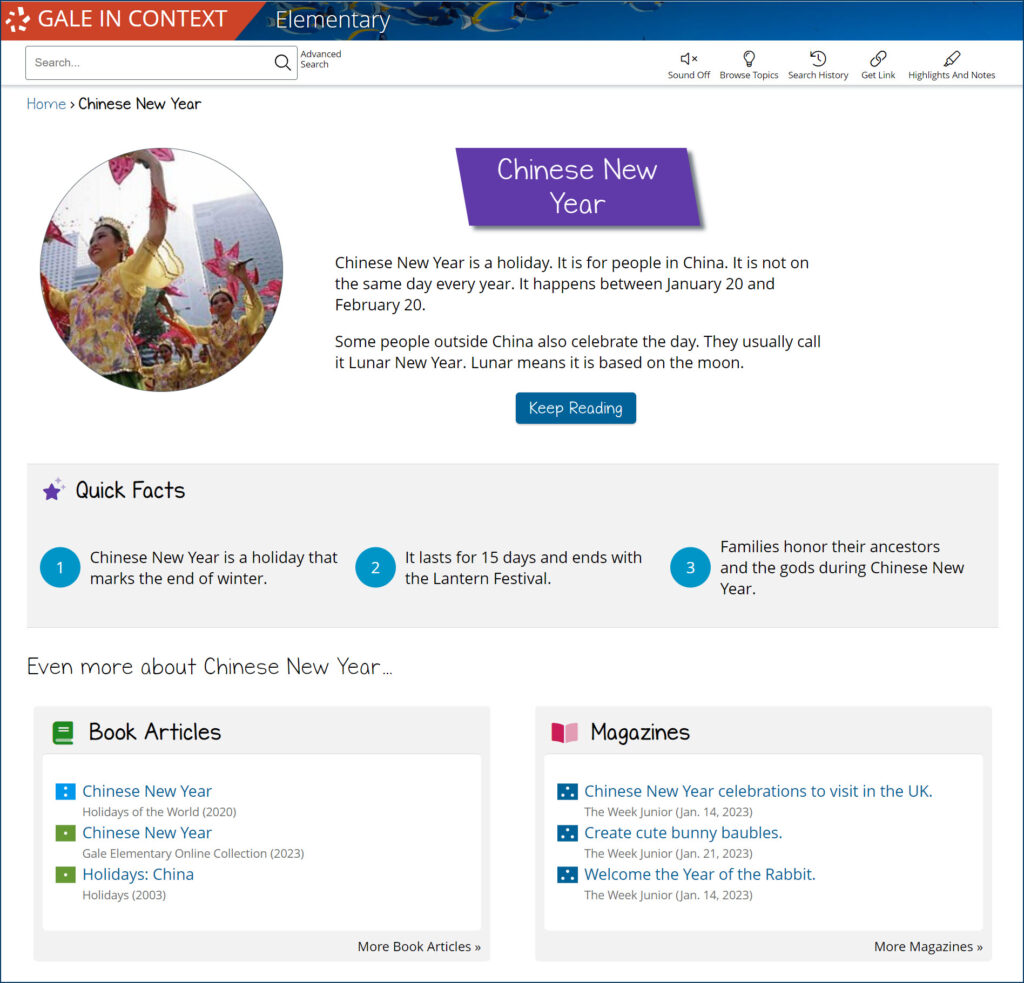| By Gale Staff |
There are dozens of ways that people in the United States celebrate the start of a new year. Whether watching the ball drop in New York City, attending a parade in Philadelphia, or plunging into frigid water in Michigan, different regions have their particular, treasured customs to welcome the new year. Most Americans also make New Year’s resolutions, taking advantage of the turning calendar year to set new goals and begin positive life changes.
To start the 2024 school year, why not make a resolution to create a unique lesson plan that focuses on different New Year’s customs in the United States and worldwide? After all, Americans aren’t the only ones who ring in the new year with exciting festivities and rituals. Plus, by adding a global perspective to this beloved holiday, you can help your young learners develop their curiosity about other countries and people.
Regardless of your lesson plan’s direction, Gale In Context: Elementary can lend a helpful hand. This extensive database is a great resource to assist your early learners in developing their beginning research skills. Colorful and age-appropriate, Elementary facilitates simple navigation features and engaging visual aids. Leverage this valuable resource after a long winter break to create an engaging welcome-back New Year’s lesson plan for your students.
Share Family New Year’s Traditions
Start your lesson by discussing New Year’s traditions at home. Ask your students: why do we celebrate New Year’s Day on January 1st? January may be the first month of our traditional Western system (based on the widely used Gregorian Calendar), but that’s not necessarily the case for everyone.
Just because people in the United States recognize New Year’s on the same date each year doesn’t mean that everyone celebrates in the same way. In New York City, people gather in Times Square to watch a live concert before counting down a sparkling ball’s descent. Cities around the country substitute their own iconic “ball drop” for New York’s crystal-covered orb. Some communities host a fireworks show at midnight. People have large, elegant parties; others stay home and share fondue. Stores are closed around the country, and Americans enjoy a final day off before school and work resume. Before expanding the lens outside the United States, consider the countless special New Year’s Eve and New Year’s Day traditions within our communities.
Discussion Idea: Have your students share their favorite New Year’s Day family traditions. Many American families cook special meals together or watch a football game. Encourage students to identify similarities between their family customs.
Introduce Chinese New Year Customs
The date for Chinese New Year, also called Lunar New Year, changes each year. For 2024, Chinese New Year lands on Saturday, February 10, and there are countless traditions for your young students to learn. Chinese New Year is a lively holiday known for its costumes, dances, and special treats. The year relates to one of twelve animals in the Chinese Zodiac, and each animal has its own characteristics that foretell what the new year brings. For example, 2024 is a year of the dragon, signifying power, honor, luck, and success.
With Gale In Context: Elementary‘s Chinese New Year portal, you and your students can explore helpful summaries, exciting magazine articles, and even a personal first-hand account of the holiday’s traditions through the eyes of an American-born Chinese individual. You also have ready-made quizzes and colorful images to incorporate into your lesson. Whatever direction you take, encourage students to find similarities between Chinese New Year customs and those of American New Year’s Eve, such as fireworks and festive meals with family. Continue to weave those shared cultural connections throughout your New Year’s lesson plans. Recognizing these cross-cultural connections will help your young learners develop a global perspective early on.

Activity Idea: Provide a mooncake recipe for students to take home for family fun. This relatively simple recipe lets students try different fillings and choose their favorites. Mooncakes are a special treat for Asian communities around the world, and they symbolize harmony and family.
Research New Year’s Traditions around the World
You’ve explored New Year’s celebrations in the United States and China, but what about the rest of the world? Australians hold a massive fireworks show over Sydney Harbour Bridge. Brazilians wear white outfits and lay flowers in the ocean. Greek families enjoy a special cake (called the St. Basil’s Cake) with a foil-wrapped chocolate coin hidden inside; the person who gets the lucky slice is believed to have good fortune for the rest of the year.
Learn even more New Year’s traditions through the varied content housed in Gale In Context: Elementary. Every article and story is curated to serve elementary-level reading and comprehension, so you can feel confident that their research is age-appropriate and academically stimulating. Elementary helps your class start the new year off on the right foot. As you learn together, why not make some class New Year’s resolutions for the upcoming semester?
Discussion Idea: After learning about the different New Year celebrations worldwide, ask your students which country they’d like to celebrate the New Year in. Go around the room and have each student explain their answer.
Teachers can get an extra time-saving boost with Gale In Context: For Educators. This teacher-specific resource works effortlessly alongside your current workflow. Featuring printable, step-by-step tip sheets and training videos, Gale In Context: For Educators helps educators master the extensive capabilities of Gale research databases, including its advanced search functionality and accessibility tools. Explore professional development materials to help you independently build your confidence as an educator. Leverage ready-made activities and lesson plans, all crafted based on state-specific curricular guidance.
Set yourself and your students up for success in 2024 and beyond. Learn more about Gale In Context and how it can help you reach your personal and professional goals this year. Contact your local Gale representative today.

